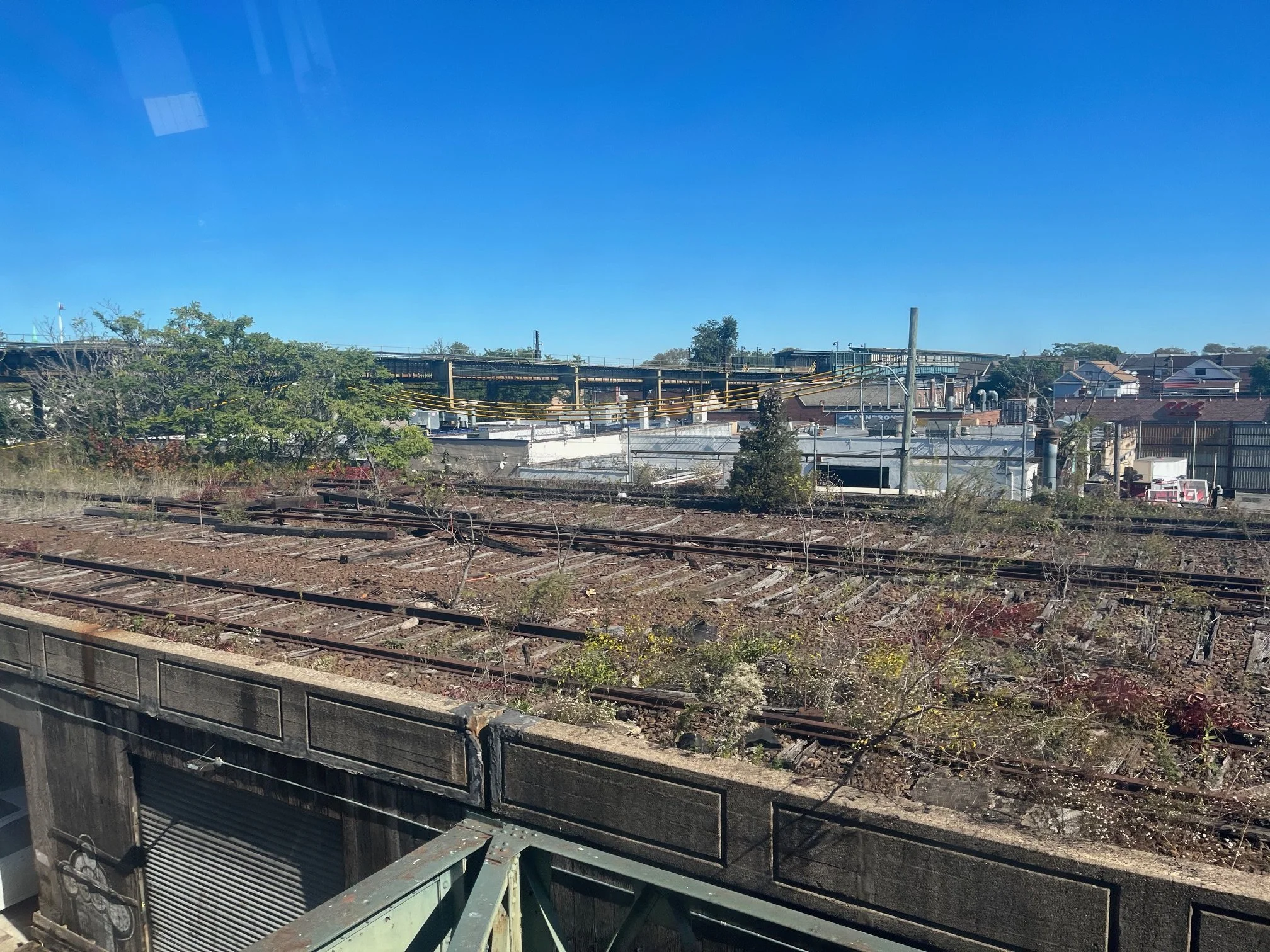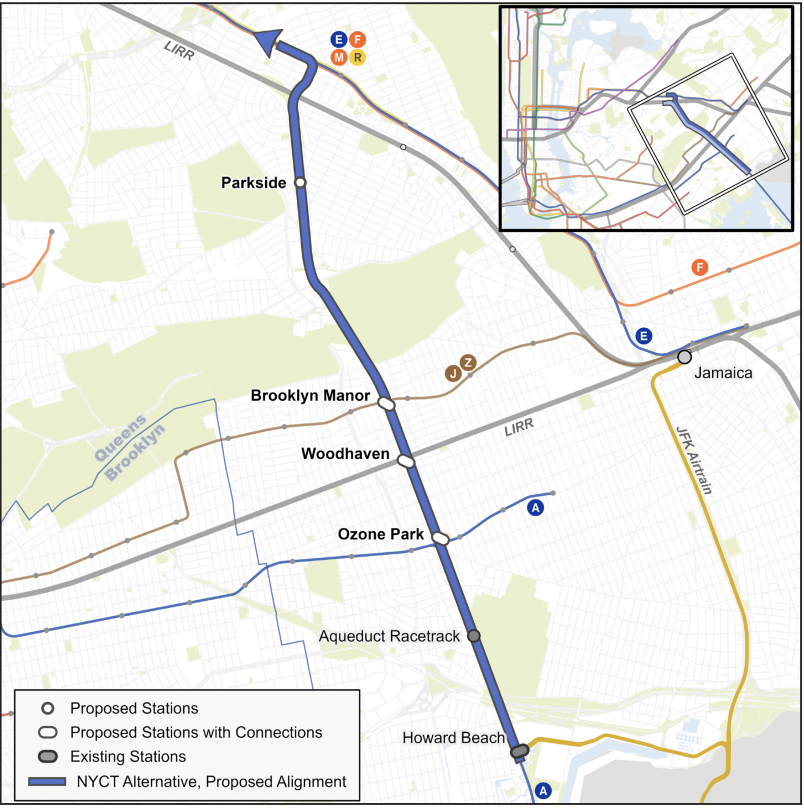On the way to QueensWay: City pitches new park project to locals
/Part of the empty train tracks that could eventually become a part of the QueensWay project. Eagle photo by Ryan Schwach
By Ryan Schwach
Parks Department officials and developers for the first time unveiled their draft plans for a linear park along an unused rail line in Forest Hills dubbed the QueensWay during a virtual meeting this week.
The first phase of the QueensWay project, funded last year by City Hall, will feature a half-mile park with open spaces, pedestrian and bike lanes and other park amenities and programs that developers are asking the public to weigh in on.
However, there remains some conflict surrounding the project, since the unused city-owned rail line that QueensWay is being built on has long been the suggested route for the transportation-centered QueensLink project. At Tuesday's meeting, several community members and transportation advocates continued to push for rail line activation alongside the QueensWay, despite the MTA’s recent insistence that the project is neither a priority of theirs nor feasible.
The first phase of the QueensWay project – funded by a $35 million infusion from Mayor Eric Adams last year, along with an additional $2.5 million from the City Council – will feature a 0.53 mile greenway called the Metropolitan Hub, or MetHub.
The MetHub will run from Metropolitan Avenue to Union Turnpike adjacent to the Metropolitan Expeditionary Learning School and several commercial spaces.
The park will specifically include open space and paths for both walking and cycling, as well as three circular “program spaces,” which could be a place for various types of community activities, city officials said.
There are hopes for potential future expansion along either direction of the unused train tracks, but so far only the first section has been fully funded.
“This project has been long in the making,” said Meira Berkower from the Parks Department. “This will be a linear park creating a greenway to allow for safe and recreational routes for pedestrians and cyclists.”
The Parks Department and consulting developers showed community members an early draft of the potential design for the QueensWay park project in Forest Hills. Screenshot via the Parks Department
The QueensWay has long been pushed by local groups, including the Friends of the QueensWay, who for more than a decade have urged city officials to create the High Line-like park on the old tracks once used to connect the Rockaway peninsula to Manhattan.
“It's an empty abandoned railway, it's completely overgrown, it's become a place for dumping,” said Angie Espino from the Economic Development Corporation. “While that rail line has been subject to various planning efforts, jumping to today, and more specifically to 2011, is where we see some real planning efforts begin to happen with the Friends of the Queensway and Trust for Public Land, who partnered together to gather local input and support in seeing this former line turn into a a greenway.”
Looking for new community space
Tuesday’s meeting specifically looked to garner input on the three program spaces and how the surrounding community would like to use the park, from potential activities they’d like to see there to open space use and other amenities.
“We're really excited that we can move forward on just the first phase of a new park for this community,” said Jana Pohorelsky from EDC. “We've heard a lot in recent years about the need for open space in all parts of Queens, but particularly in this neighborhood too and so we're excited to move forward.”
Meeting attendees were split into discussion groups on Zoom to share their thoughts on what they’d like to see in the park.
Frequently discussed were composting options, open space for kids, bathrooms and plenty of space for performances and classes.
A multiple-choice survey was sent out to all meeting attendees asking what activities they would most like to do in any future park.
The far-and-away number one response with 78 percent of the vote was “taking a walk in nature,” followed by biking, skateboarding or rollerblading, which came in second with 39 percent, and relaxing on a park bench, which came in third with 34 percent of the vote.
Some locals shared specifically what they would like to do in the park once it becomes a reality.
“I have little kids, so obviously I’d like a place for kids to be safe and to be able to just freely run around a place to sit and just enjoy the scenery,” said a community member named Delilah. “I think being able to have that would be great.”
Others in the breakout room the Eagle was placed in spoke about composting, sculptures in the vein of Astoria’s Socrates Sculpture Park and open public bathrooms.
Other suggestions included moving the main program spaces further away from the busy Union Turnpike to avoid noise pollution, and allowing space for a community garden.
Where are the trains?
For years, other Queens residents – mainly locals south of Forest Park in communities like Ozone Park and Rockaway – have long advocated for the reactivation of the Rockaway Beach rail line that once used that track in order to create faster commutes for Queens residents.
However, the funding of the QueensWay and lack of energy from the MTA to consider the project has made the rail connection for Southeast Queens ever more unlikely.
In October, the MTA submitted its 20-year needs assessment, outlining potential priorities for the next two-decades of transportation infrastructure projects in the five boroughs. In that report, QueensLink scored low, saying the idea “did not score well in most metrics” and described the project as “high cost and [serving] a relatively modest number of riders.”
The group’s executive director, Rick Horan, expressed his displeasure about the report to the Eagle following its release, even disputing the MTA’s $5.9 billion QueensLink price tag.
The QueensLink rail line project, which would bring a new train route in Queens, has been hoping to use the empty train tracks that QueensWay will be built on. Screenshot via the MTA
“We set very low expectations for them, and that's essentially been delivered,” he told the Eagle over the phone in October. “They have not shown any love for most commuters, especially with respect to North and South Queens…This is a predictable result from a less than objective or transparent study.”
However, that less-than-favorable review from the MTA has not stopped QueensLink proponents and fellow transportation advocates from giving up their rail line dreams, and on Tuesday, several community members spoke in favor of rail line connections at the QueensWay meeting.
“I really hope that there is still the potential to add some subway connections at some point,” said Adam Edwards, who described himself as a new Forest Hills resident. “I know there's been a lot of research that has gone into [QueensWay] and these designs look amazing. But as a huge public transit advocate, I hope that we don't lose that possibility.”
Other community members expressed similar sentiments, hoping that the railway could be used for both a park and a new train route.
“If there's no funding for the rail line now, if [QueensWay is] built in a way that remains compatible with transit access in the future, for example, an elevated line, that would be wonderful,” said another local, Kyber Sen. “How are people going to get there? Are they all going to drive? If there's a train that goes right there that would be wonderful.”
The amount of transit-based responses at the meeting prompted a response from the Parks Department.
“I think we mentioned at the beginning of the meeting introducing rail to this corridor would be a project that the MTA would need to pursue,” said Mitchel Loring, the project administrator for planning and policy at the Parks Department. “Right now, MTA has not expressed a public commitment to doing so…we are focusing on this city-owned land to develop a park which we have heard a lot of community interest to improve this currently abandoned piece of land in the short term, because we know that right now, the MTA does not have any priority to establish rail here.”
“However, we are making sure to share this design with the MTA so that way they can give us their comments,” Loring added.
For now, QueensWay alone remains in the community input phase, with the next community workshop scheduled for Jan 8.
The designs that the community first got the chance to look at on Tuesday are merely a draft, and developers expect to have an advanced design draft completed by early winter of 2024, with preliminary design review by the Public Design Commission coming next summer.






